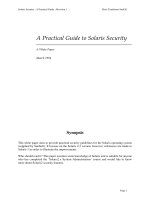IT training introduction to parallel computing a practical guide with examples in c petersen arbenz 2004 03 25
Bạn đang xem bản rút gọn của tài liệu. Xem và tải ngay bản đầy đủ của tài liệu tại đây (1.22 MB, 278 trang )
OXFORD TEXTS IN APPLIED AND ENGINEERING
MATHEMATICS
OXFORD TEXTS IN APPLIED AND ENGINEERING
MATHEMATICS
*
*
*
*
*
*
*
*
*
1.
2.
3.
4.
5.
6.
7.
8.
9.
G. D. Smith: Numerical Solution of Partial Differential Equations
3rd Edition
R. Hill: A First Course in Coding Theory
I. Anderson: A First Course in Combinatorial Mathematics 2nd Edition
D. J. Acheson: Elementary Fluid Dynamics
S. Barnett: Matrices: Methods and Applications
L. M. Hocking: Optimal Control: An Introduction to the Theory with
Applications
D. C. Ince: An Introduction to Discrete Mathematics, Formal System
Specification, and Z 2nd Edition
O. Pretzel: Error-Correcting Codes and Finite Fields
P. Grindrod: The Theory and Applications of Reaction–Diffusion Equations: Patterns
and Waves 2nd Edition
Alwyn Scott: Nonlinear Science: Emergence and Dynamics of Coherent Structures
D. W. Jordan and P. Smith: Nonlinear Ordinary Differential Equations:
An Introduction to Dynamical Systems 3rd Edition
I. J. Sobey: Introduction to Interactive Boundary Layer Theory
A. B. Tayler: Mathematical Models in Applied Mechanics (reissue)
L. Ramdas Ram-Mohan: Finite Element and Boundary Element Applications in
Quantum Mechanics
Lapeyre, et al.: Monte Carlo Methods for Transport and Diffusion Equations
I. Elishakoff and Y. Ren: Finite Element Methods for Structures with Large Stochastic
Variations
Alwyn Scott: Nonlinear Science: Emergence and Dynamics of Coherent Structures 2nd
Edition
W. P. Petersen and P. Arbenz: Introduction to Parallel Computing
Titles marked with an asterisk (*) appeared in the Oxford Applied Mathematics
and Computing Science Series, which has been folded into, and is continued by,
the current series.
Introduction to Parallel
Computing
W. P. Petersen
Seminar for Applied Mathematics
Department of Mathematics, ETHZ, Zurich
P. Arbenz
Institute for Scientific Computing
Department Informatik, ETHZ, Zurich
1
3
Great Clarendon Street, Oxford OX2 6DP
Oxford University Press is a department of the University of Oxford.
It furthers the University’s objective of excellence in research, scholarship,
and education by publishing worldwide in
Oxford New York
Auckland Cape Town Dar es Salaam Hong Kong Karachi
Kuala Lumpur Madrid Melbourne Mexico City Nairobi
New Delhi Shanghai Taipei Toronto
With offices in
Argentina Austria Brazil Chile Czech Republic France Greece
Guatemala Hungary Italy Japan Poland Portugal Singapore
South Korea Switzerland Thailand Turkey Ukraine Vietnam
Oxford is a registered trade mark of Oxford University Press
in the UK and in certain other countries
Published in the United States
by Oxford University Press Inc., New York
c Oxford University Press 2004
The moral rights of the author have been asserted
Database right Oxford University Press (maker)
First published 2004
All rights reserved. No part of this publication may be reproduced,
stored in a retrieval system, or transmitted, in any form or by any means,
without the prior permission in writing of Oxford University Press,
or as expressly permitted by law, or under terms agreed with the appropriate
reprographics rights organization. Enquiries concerning reproduction
outside the scope of the above should be sent to the Rights Department,
Oxford University Press, at the address above
You must not circulate this book in any other binding or cover
and you must impose the same condition on any acquirer
A catalogue record for this title is available from the British Library
Library of Congress Cataloging in Publication Data
(Data available)
Typeset by Newgen Imaging Systems (P) Ltd., Chennai, India
Printed in Great Britain
on acid-free paper by
Biddles Ltd., King’s Lynn, Norfolk
ISBN 0 19 851576 6 (hbk)
0 19 851577 4 (pbk)
10 9 8 7 6 5 4 3 2 1
PREFACE
The contents of this book are a distillation of many projects which have subsequently become the material for a course on parallel computing given for several
years at the Swiss Federal Institute of Technology in Ză
urich. Students in this
course have typically been in their third or fourth year, or graduate students,
and have come from computer science, physics, mathematics, chemistry, and programs for computational science and engineering. Student contributions, whether
large or small, critical or encouraging, have helped crystallize our thinking in a
quickly changing area. It is, alas, a subject which overlaps with all scientific
and engineering disciplines. Hence, the problem is not a paucity of material but
rather the distillation of an overflowing cornucopia. One of the students’ most
often voiced complaints has been organizational and of information overload. It is
thus the point of this book to attempt some organization within a quickly changing interdisciplinary topic. In all cases, we will focus our energies on floating
point calculations for science and engineering applications.
Our own thinking has evolved as well: A quarter of a century of experience in supercomputing has been sobering. One source of amusement as well as
amazement to us has been that the power of 1980s supercomputers has been
brought in abundance to PCs and Macs. Who would have guessed that vector
processing computers can now be easily hauled about in students’ backpacks?
Furthermore, the early 1990s dismissive sobriquets about dinosaurs lead us to
chuckle that the most elegant of creatures, birds, are those ancients’ successors.
Just as those early 1990s contemptuous dismissals of magnetic storage media
must now be held up to the fact that 2 GB disk drives are now 1 in. in diameter
and mounted in PC-cards. Thus, we have to proceed with what exists now and
hope that these ideas will have some relevance tomorrow.
Until the end of 2004, for the three previous years, the tip-top of the famous
Top 500 supercomputers [143] was the Yokohama Earth Simulator. Currently,
the top three entries in the list rely on large numbers of commodity processors:
65536 IBM PowerPC 440 processors at Livermore National Laboratory; 40960
IBM PowerPC processors at the IBM Research Laboratory in Yorktown Heights;
and 10160 Intel Itanium II processors connected by an Infiniband Network [75]
and constructed by Silicon Graphics, Inc. at the NASA Ames Research Centre.
The Earth Simulator is now number four and has 5120 SX-6 vector processors
from NEC Corporation. Here are some basic facts to consider for a truly high
performance cluster:
1. Modern computer architectures run internal clocks with cycles less than a
nanosecond. This defines the time scale of floating point calculations.
vi
PREFACE
2. For a processor to get a datum within a node, which sees a coherent
memory image but on a different processor’s memory, typically requires a
delay of order 1 µs. Note that this is 1000 or more clock cycles.
3. For a node to get a datum which is on a different node by using message
passing takes more than 100 or more µs.
Thus we have the following not particularly profound observations: if the data are
local to a processor, they may be used very quickly; if the data are on a tightly
coupled node of processors, there should be roughly a thousand or more data
items to amortize the delay of fetching them from other processors’ memories;
and finally, if the data must be fetched from other nodes, there should be a
100 times more than that if we expect to write-off the delay in getting them. So
it is that NEC and Cray have moved toward strong nodes, with even stronger
processors on these nodes. They have to expect that programs will have blocked
or segmented data structures. As we will clearly see, getting data from memory
to the CPU is the problem of high speed computing, not only for NEC and Cray
machines, but even more so for the modern machines with hierarchical memory.
It is almost as if floating point operations take insignificant time, while data
access is everything. This is hard to swallow: The classical books go on in depth
about how to minimize floating point operations, but a floating point operation
(flop) count is only an indirect measure of an algorithm’s efficiency. A lower flop
count only approximately reflects that fewer data are accessed. Therefore, the
best algorithms are those which encourage data locality. One cannot expect a
summation of elements in an array to be efficient when each element is on a
separate node.
This is why we have organized the book in the following manner. Basically,
we start from the lowest level and work up.
1. Chapter 1 contains a discussion of memory and data dependencies. When
one result is written into a memory location subsequently used/modified
by an independent process, who updates what and when becomes a matter
of considerable importance.
2. Chapter 2 provides some theoretical background for the applications and
examples used in the remainder of the book.
3. Chapter 3 discusses instruction level parallelism, particularly vectorization. Processor architecture is important here, so the discussion is often
close to the hardware. We take close looks at the Intel Pentium III,
Pentium 4, and Apple/Motorola G-4 chips.
4. Chapter 4 concerns shared memory parallelism. This mode assumes that
data are local to nodes or at least part of a coherent memory image shared
by processors. OpenMP will be the model for handling this paradigm.
5. Chapter 5 is at the next higher level and considers message passing. Our
model will be the message passing interface, MPI, and variants and tools
built on this system.
PREFACE
vii
Finally, a very important decision was made to use explicit examples to show
how all these pieces work. We feel that one learns by examples and by proceeding
from the specific to the general. Our choices of examples are mostly basic and
familiar: linear algebra (direct solvers for dense matrices, iterative solvers for
large sparse matrices), Fast Fourier Transform, and Monte Carlo simulations. We
hope, however, that some less familiar topics we have included will be edifying.
For example, how does one do large problems, or high dimensional ones? It is also
not enough to show program snippets. How does one compile these things? How
does one specify how many processors are to be used? Where are the libraries?
Here, again, we rely on examples.
W. P. Petersen and P. Arbenz
Authors’ comments on the corrected second printing
We are grateful to many students and colleagues who have found errata in the
one and half years since the first printing. In particular, we would like to thank
Christian Balderer, Sven Knudsen, and Abraham Nieva, who took the time to
carefully list errors they discovered. It is a difficult matter to keep up with such
a quickly changing area such as high performance computing, both regarding
hardware developments and algorithms tuned to new machines. Thus we are
indeed thankful to our colleagues for their helpful comments and criticisms.
July 1, 2005.
ACKNOWLEDGMENTS
Our debt to our students, assistants, system administrators, and colleagues
is awesome. Former assistants have made significant contributions and include
Oscar Chinellato, Dr Roman Geus, and Dr Andrea Scascighini—particularly for
their contributions to the exercises. The help of our system gurus cannot be overstated. George Sigut (our Beowulf machine), Bruno Loepfe (our Cray cluster),
and Tonko Racic (our HP9000 cluster) have been cheerful, encouraging, and
at every turn extremely competent. Other contributors who have read parts of
an always changing manuscript and who tried to keep us on track have been
Prof. Michael Mascagni and Dr Michael Vollmer. Intel Corporation’s Dr Vollmer
did so much to provide technical material, examples, advice, as well as trying
hard to keep us out of trouble by reading portions of an evolving text, that
a “thank you” hardly seems enough. Other helpful contributors were Adrian
Burri, Mario Ră
utti, Dr Olivier Byrde of Cray Research and ETH, and Dr Bruce
Greer of Intel. Despite their valiant efforts, doubtless errors still remain for which
only the authors are to blame. We are also sincerely thankful for the support and
encouragement of Professors Walter Gander, Gaston Gonnet, Martin Gutknecht,
Rolf Jeltsch, and Christoph Schwab. Having colleagues like them helps make
many things worthwhile. Finally, we would like to thank Alison Jones, Kate
Pullen, Anita Petrie, and the staff of Oxford University Press for their patience
and hard work.
CONTENTS
List of Figures
List of Tables
xv
xvii
1 BASIC ISSUES
1.1 Memory
1.2 Memory systems
1.2.1 Cache designs
1.2.2 Pipelines, instruction scheduling, and loop unrolling
1.3 Multiple processors and processes
1.4 Networks
1
1
5
5
8
15
15
2 APPLICATIONS
2.1 Linear algebra
2.2 LAPACK and the BLAS
2.2.1 Typical performance numbers for the BLAS
2.2.2 Solving systems of equations with LAPACK
2.3 Linear algebra: sparse matrices, iterative methods
2.3.1 Stationary iterations
2.3.2 Jacobi iteration
2.3.3 Gauss–Seidel (GS) iteration
2.3.4 Successive and symmetric successive overrelaxation
2.3.5 Krylov subspace methods
2.3.6 The generalized minimal residual method (GMRES)
2.3.7 The conjugate gradient (CG) method
2.3.8 Parallelization
2.3.9 The sparse matrix vector product
2.3.10 Preconditioning and parallel preconditioning
2.4 Fast Fourier Transform (FFT)
2.4.1 Symmetries
2.5 Monte Carlo (MC) methods
2.5.1 Random numbers and independent streams
2.5.2 Uniform distributions
2.5.3 Non-uniform distributions
18
18
21
22
23
28
29
30
31
31
34
34
36
39
39
42
49
55
57
58
60
64
x
CONTENTS
3 SIMD, SINGLE INSTRUCTION MULTIPLE DATA
3.1 Introduction
3.2 Data dependencies and loop unrolling
3.2.1 Pipelining and segmentation
3.2.2 More about dependencies, scatter/gather operations
3.2.3 Cray SV-1 hardware
3.2.4 Long memory latencies and short vector lengths
3.2.5 Pentium 4 and Motorola G-4 architectures
3.2.6 Pentium 4 architecture
3.2.7 Motorola G-4 architecture
3.2.8 Branching and conditional execution
3.3 Reduction operations, searching
3.4 Some basic linear algebra examples
3.4.1 Matrix multiply
3.4.2 SGEFA: The Linpack benchmark
3.5 Recurrence formulae, polynomial evaluation
3.5.1 Polynomial evaluation
3.5.2 A single tridiagonal system
3.5.3 Solving tridiagonal systems by cyclic reduction.
3.5.4 Another example of non-unit strides to achieve
parallelism
3.5.5 Some examples from Intel SSE and Motorola Altivec
3.5.6 SDOT on G-4
3.5.7 ISAMAX on Intel using SSE
3.6 FFT on SSE and Altivec
85
85
86
89
91
92
96
97
97
101
102
105
106
106
107
110
110
112
114
4 SHARED MEMORY PARALLELISM
4.1 Introduction
4.2 HP9000 Superdome machine
4.3 Cray X1 machine
4.4 NEC SX-6 machine
4.5 OpenMP standard
4.6 Shared memory versions of the BLAS and LAPACK
4.7 Basic operations with vectors
4.7.1 Basic vector operations with OpenMP
4.8 OpenMP matrix vector multiplication
4.8.1 The matrix–vector multiplication with OpenMP
4.8.2 Shared memory version of SGEFA
4.8.3 Shared memory version of FFT
4.9 Overview of OpenMP commands
4.10 Using Libraries
136
136
136
137
139
140
141
142
143
146
147
149
151
152
153
117
122
123
124
126
CONTENTS
xi
5 MIMD, MULTIPLE INSTRUCTION, MULTIPLE DATA
5.1 MPI commands and examples
5.2 Matrix and vector operations with PBLAS and BLACS
5.3 Distribution of vectors
5.3.1 Cyclic vector distribution
5.3.2 Block distribution of vectors
5.3.3 Block–cyclic distribution of vectors
5.4 Distribution of matrices
5.4.1 Two-dimensional block–cyclic matrix distribution
5.5 Basic operations with vectors
5.6 Matrix–vector multiply revisited
5.6.1 Matrix–vector multiplication with MPI
5.6.2 Matrix–vector multiply with PBLAS
5.7 ScaLAPACK
5.8 MPI two-dimensional FFT example
5.9 MPI three-dimensional FFT example
5.10 MPI Monte Carlo (MC) integration example
5.11 PETSc
5.11.1 Matrices and vectors
5.11.2 Krylov subspace methods and preconditioners
5.12 Some numerical experiments with a PETSc code
156
158
161
165
165
168
169
170
170
171
172
172
173
177
180
184
187
190
191
193
194
APPENDIX A SSE INTRINSICS FOR FLOATING POINT
A.1
Conventions and notation
A.2
Boolean and logical intrinsics
A.3
Load/store operation intrinsics
A.4
Vector comparisons
A.5
Low order scalar in vector comparisons
A.6
Integer valued low order scalar in vector comparisons
A.7
Integer/floating point vector conversions
A.8
Arithmetic function intrinsics
201
201
201
202
205
206
206
206
207
APPENDIX B ALTIVEC INTRINSICS FOR FLOATING
POINT
B.1
Mask generating vector comparisons
B.2
Conversion, utility, and approximation functions
B.3
Vector logical operations and permutations
B.4
Load and store operations
B.5
Full precision arithmetic functions on vector operands
B.6
Collective comparisons
211
211
212
213
214
215
216
xii
APPENDIX C
CONTENTS
OPENMP COMMANDS
218
APPENDIX D SUMMARY OF MPI COMMANDS
D.1
Point to point commands
D.2
Collective communications
D.3
Timers, initialization, and miscellaneous
220
220
226
234
APPENDIX E
FORTRAN AND C COMMUNICATION
235
APPENDIX F
GLOSSARY OF TERMS
240
APPENDIX G
NOTATIONS AND SYMBOLS
245
References
Index
246
255
LIST OF FIGURES
1.1
1.2
1.3
1.4
1.5
1.6
1.7
1.8
1.9
1.10
1.11
1.12
1.13
2.1
2.2
2.3
2.4
2.5
2.6
2.7
2.8
2.9
2.10
2.11
2.12
2.13
2.14
2.15
Intel microprocessor transistor populations since 1972.
Linpack benchmark optimal performance tests.
Memory versus CPU performance.
Generic machine with cache memory.
Caches and associativity.
Data address in set associative cache memory.
Pipelining: a pipe filled with marbles.
Pre-fetching 2 data one loop iteration ahead (assumes 2|n).
Aligning templates of instructions generated by unrolling loops.
Aligning templates and hiding memory latencies by pre-fetching data.
Ω-network.
Ω-network switches.
Two-dimensional nearest neighbor connected torus.
Gaussian elimination of an M × N matrix based on Level 2 BLAS
as implemented in the LAPACK routine dgetrf.
Block Gaussian elimination.
The main loop in the LAPACK routine dgetrf, which is
functionally equivalent to dgefa from LINPACK.
Stationary iteration for solving Ax = b with preconditioner M .
The preconditioned GMRES(m) algorithm.
The preconditioned conjugate gradient algorithm.
Sparse matrix–vector multiplication y = Ax with the matrix A
stored in the CSR format.
Sparse matrix with band-like nonzero structure row-wise block
distributed on six processors.
Sparse matrix–vector multiplication y = AT x with the matrix A
stored in the CSR format.
9×9 grid and sparsity pattern of the corresponding Poisson matrix
if grid points are numbered in lexicographic order.
9×9 grid and sparsity pattern of the corresponding Poisson matrix
if grid points are numbered in checkerboard (red-black) ordering.
9×9 grid and sparsity pattern of the corresponding Poisson matrix
if grid points are arranged in checkerboard (red-black) ordering.
Overlapping domain decomposition.
The incomplete Cholesky factorization with zero fill-in.
Graphical argument why parallel RNGs should generate parallel
streams.
2
2
3
4
5
7
9
11
13
13
15
16
17
24
26
27
33
37
38
40
41
42
44
44
45
46
48
63
xiv
LIST OF FIGURES
2.16 Timings for Box–Muller method vs. polar method for generating
univariate normals.
2.17 AR method.
2.18 Polar method for normal random variates.
2.19 Box–Muller vs. Ziggurat method.
2.20 Timings on NEC SX-4 for uniform interior sampling of an n-sphere.
2.21 Simulated two-dimensional Brownian motion.
2.22 Convergence of the optimal control process.
3.1 Four-stage multiply pipeline: C = A ∗ B.
3.2 Scatter and gather operations.
3.3 Scatter operation with a directive telling the C compiler to ignore
any apparent vector dependencies.
3.4 Cray SV-1 CPU diagram.
3.5 saxpy operation by SIMD.
3.6 Long memory latency vector computation.
3.7 Four-stage multiply pipeline: C = A ∗ B with out-of-order
instruction issue.
3.8 Another way of looking at Figure 3.7.
3.9 Block diagram of Intel Pentium 4 pipelined instruction execution
unit.
3.10 Port structure of Intel Pentium 4 out-of-order instruction core.
3.11 High level overview of the Motorola G-4 structure, including the
Altivec technology.
3.12 Branch processing by merging results.
3.13 Branch prediction best when e(x) > 0.
3.14 Branch prediction best if e(x) ≤ 0.
3.15 Simple parallel version of SGEFA.
3.16 Times for cyclic reduction vs. the recursive procedure.
3.17 In-place, self-sorting FFT.
3.18 Double “bug” for in-place, self-sorting FFT.
3.19 Data misalignment in vector reads.
3.20 Workspace version of self-sorting FFT.
3.21 Decimation in time computational “bug”.
3.22 Complex arithmetic for d = wk (a − b) on SSE and Altivec.
3.23 Intrinsics, in-place (non-unit stride), and generic FFT. Ito: 1.7 GHz
Pentium 4
3.24 Intrinsics, in-place (non-unit stride), and generic FFT. Ogdoad:
1.25 GHz Power Mac G-4.
4.1 One cell of the HP9000 Superdome.
4.2 Crossbar interconnect architecture of the HP9000 Superdome.
4.3 Pallas EFF BW benchmark.
4.4 EFF BW benchmark on Stardust.
4.5 Cray X1 MSP.
4.6 Cray X1 node (board).
4.7 NEC SX-6 CPU.
67
68
70
72
74
79
80
90
91
91
93
94
96
98
99
100
100
101
102
104
104
108
115
120
121
123
127
127
128
130
133
136
137
137
138
138
139
140
4.8
4.9
4.10
4.11
4.12
4.13
4.14
4.15
5.1
5.2
5.3
5.4
5.5
5.6
5.7
5.8
5.9
5.10
5.11
5.12
5.13
5.14
5.15
5.16
5.17
5.18
5.19
5.20
5.21
5.22
5.23
5.24
5.25
5.26
5.27
LIST OF FIGURES
xv
NEC SX-6 node.
Global variable dot unprotected, and thus giving incorrect results
(version I).
OpenMP critical region protection for global variable dot
(version II).
OpenMP critical region protection only for local accumulations
local dot (version III).
OpenMP reduction syntax for dot (version IV).
Times and speedups for parallel version of classical Gaussian
elimination, SGEFA.
Simple minded approach to parallelizing one n = 2m FFT using
OpenMP on Stardust.
Times and speedups for the Hewlett-Packard MLIB version
LAPACK routine sgetrf.
Generic MIMD distributed-memory computer (multiprocessor).
Network connection for ETH Beowulf cluster.
MPI status struct for send and receive functions.
MPICH compile script.
MPICH (PBS) batch run script.
LAM (PBS) run script.
The ScaLAPACK software hierarchy.
Initialization of a BLACS process grid.
Eight processes mapped on a 2 × 4 process grid in row-major order.
Release of the BLACS process grid.
Cyclic distribution of a vector.
Block distribution of a vector.
Block–cyclic distribution of a vector.
Block–cyclic distribution of a 15 × 20 matrix on a 2 × 3 processor
grid with blocks of 2 × 3 elements.
The data distribution in the matrix–vector product A ∗ x = y with
five processors.
MPI matrix–vector multiply with row-wise block-distributed
matrix.
Block–cyclic matrix and vector allocation.
The 15 × 20 matrix A stored on a 2 × 4 process grid with big
blocks together with the 15-vector y and the 20-vector x.
Defining the matrix descriptors.
General matrix–vector multiplication with PBLAS.
Strip-mining a two-dimensional FFT.
Two-dimensional transpose for complex data.
A domain decomposition MC integration.
Cutting and pasting a uniform sample on the points.
The PETSc software building blocks.
Definition and initialization of a n × n Poisson matrix.
Definition and initialization of a vector.
140
144
144
145
146
150
152
154
157
157
159
162
162
163
163
167
167
167
168
168
169
171
173
174
175
175
176
176
180
181
188
188
190
191
192
xvi
LIST OF FIGURES
5.28 Definition of the linear solver context and of the Krylov subspace
method.
5.29 Definition of the preconditioner, Jacobi in this case.
5.30 Calling the PETSc solver.
5.31 Defining PETSc block sizes that coincide with the blocks of the
Poisson matrix.
193
194
194
195
LIST OF TABLES
1.1
2.1
2.2
2.3
2.4
2.5
2.6
2.7
2.8
4.1
4.2
4.3
4.4
5.1
5.2
5.3
5.4
5.5
A.1
B.1
B.2
D.1
D.2
Cache structures for Intel Pentium III, 4, and Motorola G-4.
Basic linear algebra subprogram prefix/suffix conventions.
Summary of the basic linear algebra subroutines.
Number of memory references and floating point operations for
vectors of length n.
Some performance numbers for typical BLAS in Mflop/s for a
2.4 GHz Pentium 4.
Times (s) and speed in Mflop/s of dgesv on a P 4 (2.4 GHz, 1 GB).
Iteration steps for solving the Poisson equation on a 31 × 31 and on
a 63×63 grid.
Some Krylov subspace methods for Ax = b with nonsingular A.
Iteration steps for solving the Poisson equation on a 31 × 31 and on
a 63 × 63 grid.
Times t in seconds (s) and speedups S(p) for various problem sizes
n and processor numbers p for solving a random system of
equations with the general solver dgesv of LAPACK on the HP
Superdome.
Some execution times in microseconds for the saxpy operation.
Execution times in microseconds for our dot product, using the C
compiler guidec.
Some execution times in microseconds for the matrix–vector
multiplication with OpenMP on the HP superdome.
Summary of the BLACS.
Summary of the PBLAS.
Timings of the ScaLAPACK system solver pdgesv on one processor
and on 36 processors with varying dimensions of the process grid.
Times t and speedups S(p) for various problem sizes n and
processor numbers p for solving a random system of equations with
the general solver pdgesv of ScaLAPACK on the Beowulf cluster.
Execution times for solving an n2 × n2 linear system from the
two-dimensional Poisson problem.
Available binary relations for the mm compbr ps and
mm compbr ss intrinsics.
Available binary relations for comparison functions.
Additional available binary relations for collective comparison
functions.
MPI datatypes available for collective reduction operations.
MPI pre-defined constants.
4
19
20
22
23
28
33
35
39
141
143
145
148
164
166
179
179
195
203
212
216
230
231
This page intentionally left blank
1
BASIC ISSUES
No physical quantity can continue to change exponentially forever.
Your job is delaying forever.
G. E. Moore (2003)
1.1
Memory
Since first proposed by Gordon Moore (an Intel founder) in 1965, his law [107]
that the number of transistors on microprocessors doubles roughly every one to
two years has proven remarkably astute. Its corollary, that central processing unit
(CPU) performance would also double every two years or so has also remained
prescient. Figure 1.1 shows Intel microprocessor data on the number of transistors beginning with the 4004 in 1972. Figure 1.2 indicates that when one includes
multi-processor machines and algorithmic development, computer performance
is actually better than Moore’s 2-year performance doubling time estimate. Alas,
however, in recent years there has developed a disagreeable mismatch between
CPU and memory performance: CPUs now outperform memory systems by
orders of magnitude according to some reckoning [71]. This is not completely
accurate, of course: it is mostly a matter of cost. In the 1980s and 1990s, Cray
Research Y-MP series machines had well balanced CPU to memory performance.
Likewise, NEC (Nippon Electric Corp.), using CMOS (see glossary, Appendix F)
and direct memory access, has well balanced CPU/Memory performance. ECL
(see glossary, Appendix F) and CMOS static random access memory (SRAM)
systems were and remain expensive and like their CPU counterparts have to
be carefully kept cool. Worse, because they have to be cooled, close packing is
difficult and such systems tend to have small storage per volume. Almost any personal computer (PC) these days has a much larger memory than supercomputer
memory systems of the 1980s or early 1990s. In consequence, nearly all memory
systems these days are hierarchical, frequently with multiple levels of cache.
Figure 1.3 shows the diverging trends between CPUs and memory performance.
Dynamic random access memory (DRAM) in some variety has become standard
for bulk memory. There are many projects and ideas about how to close this performance gap, for example, the IRAM [78] and RDRAM projects [85]. We are
confident that this disparity between CPU and memory access performance will
eventually be tightened, but in the meantime, we must deal with the world as it
is. Anyone who has recently purchased memory for a PC knows how inexpensive
2
BASIC ISSUES
105
Intel CPUs
Itanium
Pentium-II-4
Pentium
(2.5 year
80486
doubling)
Number of transistors
104
103
80386
80286
102
8086
101
(Line fit = 2 year doubling)
4004
100
1970
1980
1990
2000
Year
Fig. 1.1. Intel microprocessor transistor populations since 1972.
108
10
7
Super Linpack Rmax
[fit: 1 year doubling]
ES
MFLOP/s
106
Cray T–3D
105
104
NEC SX–3
Fujitsu VP2600
103
102
Cray–1
101
1980
1990
Year
2000
Fig. 1.2. Linpack benchmark optimal performance tests. Only some of the fastest
machines are indicated: Cray-1 (1984) had 1 CPU; Fujitsu VP2600 (1990)
had 1 CPU; NEC SX-3 (1991) had 4 CPUS; Cray T-3D (1996) had 2148
DEC α processors; and the last, ES (2002), is the Yokohama NEC Earth
Simulator with 5120 vector processors. These data were gleaned from various
years of the famous dense linear equations benchmark [37].
MEMORY
3
10,000
Data rate (MHz)
= CPU
= SRAM
= DRAM
1000
100
10
1990
1995
2000
2005
Year
Fig. 1.3. Memory versus CPU performance: Samsung data [85]. Dynamic RAM
(DRAM) is commonly used for bulk memory, while static RAM (SRAM) is
more common for caches. Line extensions beyond 2003 for CPU performance
are via Moore’s law.
DRAM has become and how large it permits one to expand their system. Economics in part drives this gap juggernaut and diverting it will likely not occur
suddenly. However, it is interesting that the cost of microprocessor fabrication
has also grown exponentially in recent years, with some evidence of manufacturing costs also doubling in roughly 2 years [52] (and related articles referenced
therein). Hence, it seems our first task in programming high performance computers is to understand memory access. Computer architectural design almost
always assumes a basic principle —that of locality of reference. Here it is:
The safest assumption about the next data to be used is that they are
the same or nearby the last used.
Most benchmark studies have shown that 90 percent of the computing time is
spent in about 10 percent of the code. Whereas the locality assumption is usually
accurate regarding instructions, it is less reliable for other data. Nevertheless, it
is hard to imagine another strategy which could be easily implemented. Hence,
most machines use cache memory hierarchies whose underlying assumption is
that of data locality. Non-local memory access, in particular, in cases of non-unit
but fixed stride, are often handled with pre-fetch strategies—both in hardware
and software. In Figure 1.4, we show a more/less generic machine with two
levels of cache. As one moves up in cache levels, the larger the cache becomes,
the higher the level of associativity (see Table 1.1 and Figure 1.5), and the lower
the cache access bandwidth. Additional levels are possible and often used, for
example, L3 cache in Table 1.1.
4
BASIC ISSUES
System bus
Memory
L2 cache
Bus interface unit
Instruction cache
Fetch and
decode unit
L1 data cache
Execution unit
Fig. 1.4. Generic machine with cache memory.
Table 1.1
Cache structures for Intel Pentium III, 4, and Motorola G-4.
Pentium III memory access data
Channel:
Width
Size
Clocking
Bandwidth
Channel:
Width
Size
Clocking
Bandwidth
Channel:
Width
Size
Clocking
Bandwidth
M ↔ L2
64-bit
256 kB (L2)
133 MHz
1.06 GB/s
L2 ↔ L1
64-bit
8 kB (L1)
275 MHz
2.2 GB/s
L1 ↔ Reg.
64-bit
8·16 B (SIMD)
550 MHz
4.4 GB/s
Pentium 4 memory access data
M ↔ L2
L2 ↔ L1
64-bit
256-bit
256 kB (L2)
8 kB (L1)
533 MHz
3.06 GHz
4.3 GB/s
98 GB/s
L1 ↔ Reg.
256-bit
8·16 B (SIMD)
3.06 GHz
98 GB/s
Power Mac G-4 memory
M ↔ L3
L3 ↔ L2
64-bit
256-bit
2 MB
256 kB
250 MHz
1.25 GHz
2 GB/s
40 GB/s
access data
L2 ↔ L1
256-bit
32 kB
1.25 GHz
40 GB/s
L1 ↔ Reg.
128-bit
32·16 B (SIMD)
1.25 GHz
20.0 GB/s
MEMORY SYSTEMS
Fully associative
5
2-way associative
Direct mapped
12 mod 4
12 mod 8
0
4
Memory
12
Fig. 1.5. Caches and associativity. These very simplified examples have caches
with 8 blocks: a fully associative (same as 8-way set associative in this case),
a 2-way set associative cache with 4 sets, and a direct mapped cache (same
as 1-way associative in this 8 block example). Note that block 4 in memory
also maps to the same sets in each indicated cache design having 8 blocks.
1.2
Memory systems
In Figure 3.4 depicting the Cray SV-1 architecture, one can see that it is possible
for the CPU to have a direct interface to the memory. This is also true for other
supercomputers, for example, the NEC SX-4,5,6 series, Fujitsu AP3000, and
others. The advantage to this direct interface is that memory access is closer in
performance to the CPU. In effect, all the memory is cache. The downside is that
memory becomes expensive and because of cooling requirements, is necessarily
further away. Early Cray machines had twisted pair cable interconnects, all of
the same physical length. Light speed propagation delay is almost exactly 1 ns
in 30 cm, so a 1 ft waveguide forces a delay of order one clock cycle, assuming
a 1.0 GHz clock. Obviously, the further away the data are from the CPU, the
longer it takes to get. Caches, then, tend to be very close to the CPU—on-chip, if
possible. Table 1.1 indicates some cache sizes and access times for three machines
we will be discussing in the SIMD Chapter 3.
1.2.1 Cache designs
So what is a cache, how does it work, and what should we know to intelligently program? According to a French or English dictionary, it is a safe place
to hide things. This is perhaps not an adequate description of cache with regard
6
BASIC ISSUES
to a computer memory. More accurately, it is a safe place for storage that is close
by. Since bulk storage for data is usually relatively far from the CPU, the principle of data locality encourages having a fast data access for data being used,
hence likely to be used next, that is, close by and quickly accessible. Caches,
then, are high speed CMOS or BiCMOS memory but of much smaller size than
the main memory, which is usually of DRAM type.
The idea is to bring data from memory into the cache where the CPU can
work on them, then modify and write some of them back to memory. According
to Hennessey and Patterson [71], about 25 percent of memory data traffic is
writes, and perhaps 9–10 percent of all memory traffic. Instructions are only
read, of course. The most common case, reading data, is the easiest. Namely,
data read but not used pose no problem about what to do with them—they are
ignored. A datum from memory to be read is included in a cacheline (block)
and fetched as part of that line. Caches can be described as direct mapped or
set associative:
• Direct mapped means a data block can go only one place in the cache.
• Set associative means a block can be anywhere within a set. If there are
m sets, the number of blocks in a set is
n = (cache size in blocks)/m,
and the cache is called an n−way set associative cache. In Figure 1.5 are
three types namely, an 8-way or fully associative, a 2-way, and a direct
mapped.
In effect, a direct mapped cache is set associative with each set consisting of
only one block. Fully associative means the data block can go anywhere in the
cache. A 4-way set associative cache is partitioned into sets each with 4 blocks;
an 8-way cache has 8 cachelines (blocks) in each set and so on. The set where
the cacheline is to be placed is computed by
(block address) mod (m = no. of sets in cache).
The machines we examine in this book have both 4-way set associative and
8-way set associative caches. Typically, the higher the level of cache, the larger
the number of sets. This follows because higher level caches are usually much
larger than lower level ones and search mechanisms for finding blocks within
a set tend to be complicated and expensive. Thus, there are practical limits on
the size of a set. Hence, the larger the cache, the more sets are used. However,
the block sizes may also change. The largest possible block size is called a page
and is typically 4 kilobytes (kb). In our examination of SIMD programming on
cache memory architectures (Chapter 3), we will be concerned with block sizes
of 16 bytes, that is, 4 single precision floating point words. Data read from cache
into vector registers (SSE or Altivec) must be aligned on cacheline boundaries.
Otherwise, the data will be mis-aligned and mis-read: see Figure 3.19. Figure 1.5









